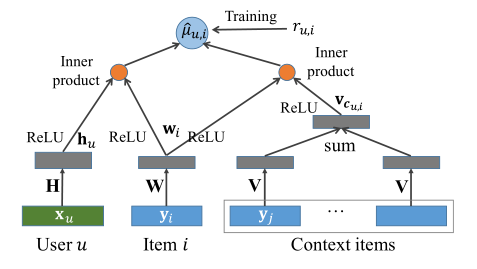NPE¶
Introduction¶
Title: NPE: Neural Personalized Embedding for Collaborative Filtering.
Authors: Ying, H
Abstract: Matrix factorization is one of the most efficient approaches in recommender systems. However, such algorithms, which rely on the interactions between users and items, perform poorly for “cold-users” (users with little history of such interactions) and at capturing the relationships between closely related items. To address these problems, we propose a neural personalized embedding (NPE) model, which improves the recommendation performance for cold-users and can learn effective representations of items. It models a user’s click to an item in two terms: the personal preference of the user for the item, and the relationships between this item and other items clicked by the user. We show that NPE outperforms competing methods for top-N recommendations, specially for cold-user recommendations. We also performed a qualitative analysis that shows the effectiveness of the representations learned by the model.

Running with RecBole¶
Model Hyper-Parameters:
embedding_size (int): The embedding size of users and items. Defaults to64.dropout_prob (float): The dropout rate. Defaults to0.3.loss_type (str): The type of loss function. If it set to'CE', the training task is regarded as a multi-classification task and the target item is the ground truth. In this way, negative sampling is not needed. If it set to'BPR', the training task will be optimized in the pair-wise way, which maximize the difference between positive item and negative item. In this way, negative sampling is necessary, such as setting--neg_sampling="{'uniform': 1}". Defaults to'CE'. Range in['BPR', 'CE'].
A Running Example:
Write the following code to a python file, such as run.py
from recbole.quick_start import run_recbole
parameter_dict = {
'neg_sampling': None,
}
run_recbole(model='NPE', dataset='ml-100k', config_dict=parameter_dict)
And then:
python run.py
Notes:
By setting
reproducibility=False, the training speed of NPE can be greatly accelerated.
Tuning Hyper Parameters¶
If you want to use HyperTuning to tune hyper parameters of this model, you can copy the following settings and name it as hyper.test.
learning_rate choice [0.001]
embedding_size choice [64]
dropout_prob choice [0.2,0.3,0.5]
Note that we just provide these hyper parameter ranges for reference only, and we can not guarantee that they are the optimal range of this model.
Then, with the source code of RecBole (you can download it from GitHub), you can run the run_hyper.py to tuning:
python run_hyper.py --model=[model_name] --dataset=[dataset_name] --config_files=[config_files_path] --params_file=hyper.test
For more details about Parameter Tuning, refer to Parameter Tuning.
If you want to change parameters, dataset or evaluation settings, take a look at